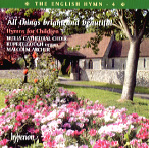Although subtitled “Hymns for Children”, this Volume 4 in Hyperion’s English Hymn series includes some of the genre’s most enduring, universally revered, all-age constituents–the kind that you may first hear and sing as a child but carry with you the rest of your life. Those who know this repertoire will be pleased to find such standards as All things bright and beautiful (W.H. Monk’s tune) and There is a green hill far away (Horsley)–two of the classics with words by Mrs. (Cecil Frances) Alexander, who in the 19th century wrote many hymns ostensibly as a means of teaching her godchildren the Creed. (Once in royal David’s city, not included here, is another of her more famous “instructional” efforts.) Other of the more sophisticated, adult-favorite selections are the great processional All glory, laud, and honor (St. Theodulph), Percy Dearmer’s He who would valiant be (set to Vaughan Williams’ arrangement of the tune Monk’s Gate), and Dear Lord and Father of mankind (words by Whittier), set to Hubert Parry’s very beautiful and moving tune Repton.
Among the more specifically child-oriented hymns are William Parker’s Tell me the stories of Jesus, There’s a Friend for little children (to John Stainer’s tune In Memoriam), Away in a Manger (the William Kirkpatrick melody), Little Jesus, sweetly sleep (Rocking), Morning has broken, and What a friend we have in Jesus, a perennial favorite of traditional and fundamentalist Protestant congregations in the U.S.–as is Onward Christian soldiers, sung here with a decidedly tamer militant tone than is often heard in renditions by choirs on this side of the Atlantic.
The informative, often humorous notes prove a significant asset to this collection. Not only do they succinctly describe each hymn’s provenance, with a few tidbits about the authors and composers, but they also aren’t afraid to cite weaknesses, either in the poetry or theology of several entries. There are few weaknesses in the singing, however: this is a choir, as with any English cathedral choir, that knows, lives, and breathes this music, and only occasionally does a particular section (basses and tenors, mostly) get a little overzealous in its delivery. Because of the bigness of the space, some hymns–the ones requiring a lighter feel and faster tempo, such as Lord of the dance–come off a bit cumbersome, the choir and organ’s effort at clean articulation somewhat swallowed in the acoustic. But this is the sound of cathedral hymn-singing–and thankfully without the inevitable, often overwhelming tempo-smudging, pitch-fudging presence of congregation and clergy! If you love English hymns, this will be another essential addition to the library–and you likely will discover a few new tunes and texts, as I did, to remind you of the infinite variety and profound capacity for inspiration embodied in this very special music.
































